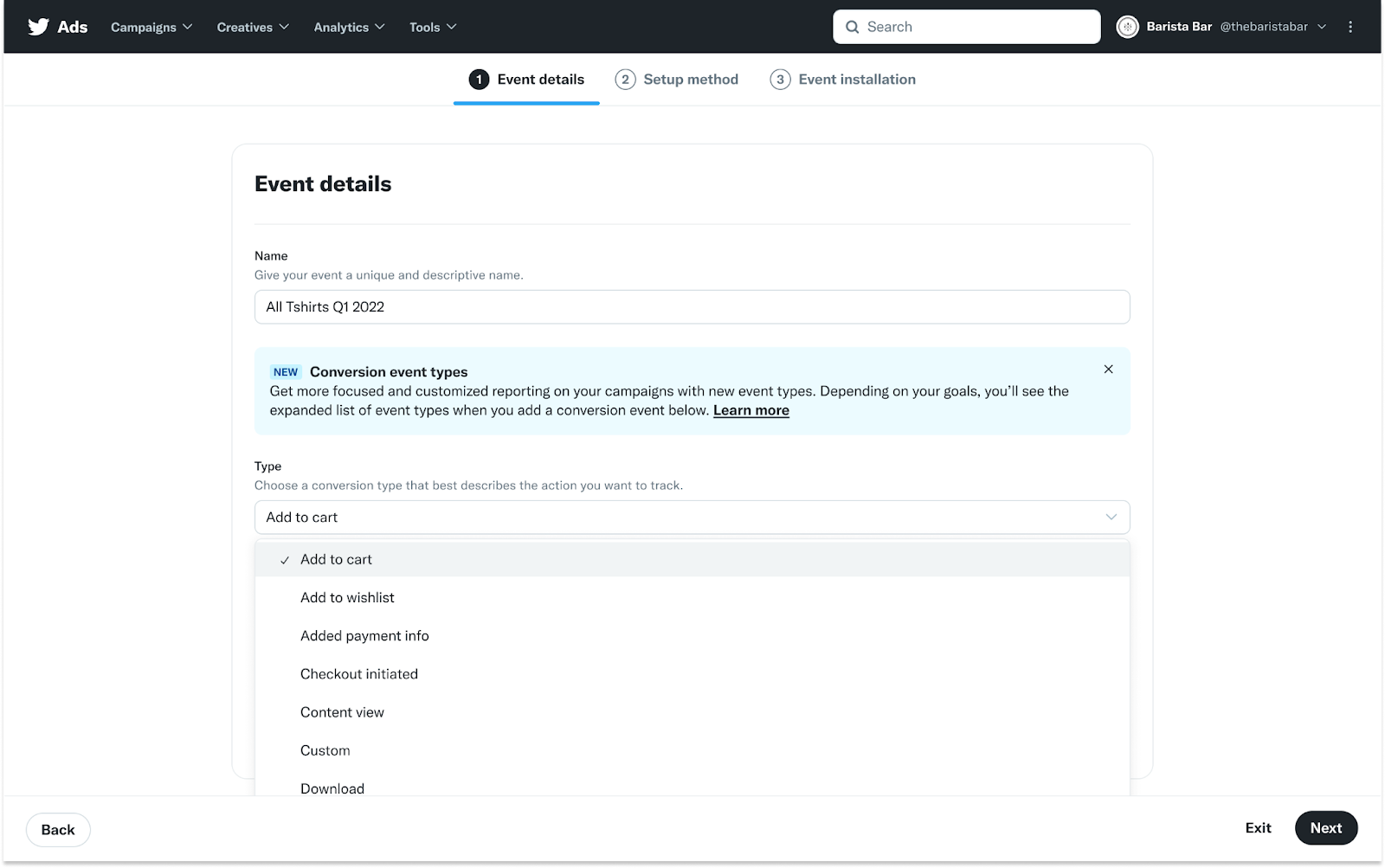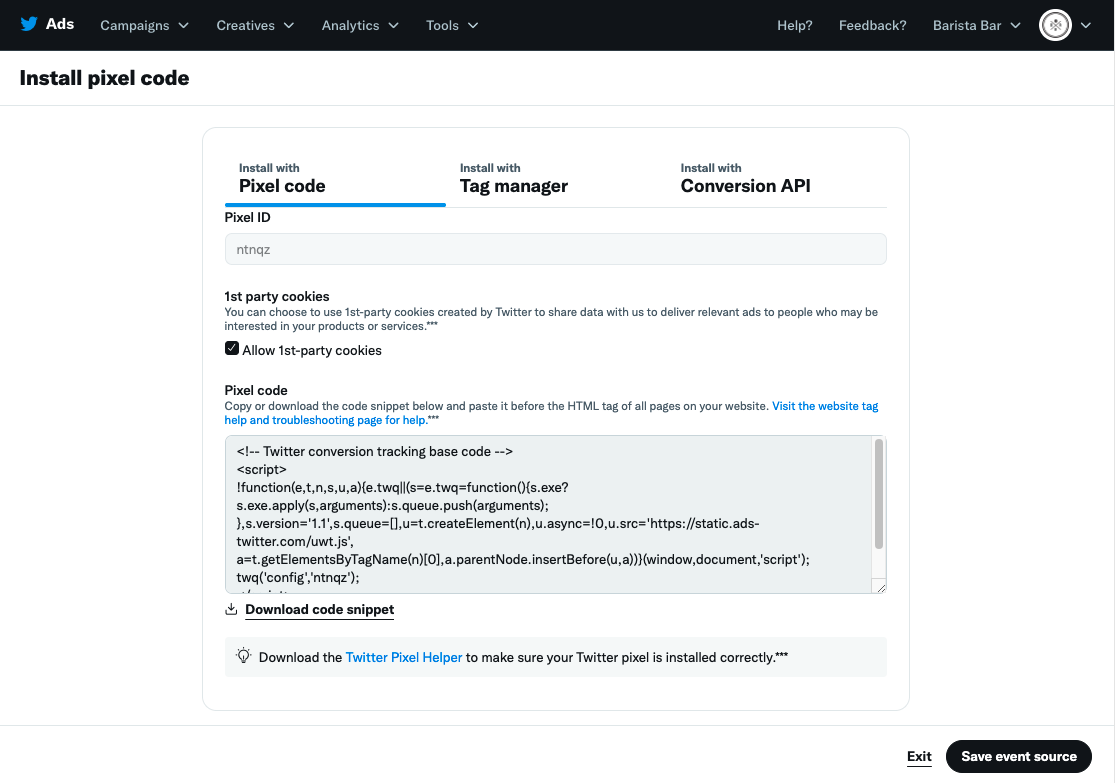
X Ads
Website traffic campaign
Ready to advertise on X?
Ready to advertise on X?
Website traffic campaign
Recent news
Check out our blog post on website performance improvements where we go into detail on 3 products: Site Visits Optimization, Aggregated Measurement, and Events Manager.
Dynamic Product Ads (DPA) allow advertisers to showcase the most relevant product to the right customer at the right time to drive sales and conversions.
How does this work?
With DPA Retargeting, you can serve ads to targeted consumers, featuring products they have engaged with (e.g. added to their shopping cart) on your website but haven’t yet purchased.
With DPA Prospecting, you can acquire new customers who haven’t visited your website via ads featuring specific products that are most relevant to them.
Advertisers that use a feed management platform for their product catalog can simply extend product strategies onto X with integrated X Marketing Partners.
In our initial testing, cost-per-acquisition improved by 30-88% for advertisers who used Dynamic Product Ads. As with WCO, DPA Retargeting requires use of the X Pixel or Conversion API to optimize with behavior from your site. DPA Prospecting performance benefits from X Pixel or Conversion API implementation but does not require it.
Learn more about setting up a dynamic product ads campaign on this page.
With our all new X Pixel and Conversions API, you can measure Web results in the way that works best for you.
What are these two solutions?
The new X Pixel, which is a website tag that is implemented on your website to track site actions or conversions.
The Conversions API is a direct, server-to-server integration that allows you to share data without the need for a website code implementation.
Both solutions achieve the same goal and have largely the same functionality: enabling conversion tracking for your web campaigns. It is critical to implement or upgrade to at least one of these options in order to unlock the full capabilities of web campaigns.
Choosing the right solution:
For most advertisers, we recommend using the X Pixel. If you are just getting started, the X Pixel can be the most straightforward solution to get set up.
If you have key considerations with regards to your website (example: unable to implement JavaScript on your website), then the Conversions API may be the best option.
Note: if you previously had an X Universal Web Tag or Single Event Tag implemented, we recommend that you upgrade your previous website code to the new X Pixel code.
Read more about these updates on this page.
With all new event types and parameters, updates to our Click ID functionality, and more, you can better attribute and measure website actions. Learn more about all of these updates on this page.
Code based events
Code based events let you directly implement a Web event with code. This allows you to more reliably track actions and send key information back via event parameters. These events can also be implemented using the Conversion API.
New Event Types and Parameters
We are releasing new event types and event parameters to enable you to measure more actions, and pass back additional key details about the action taken.
- New event types: Lead, Add to Cart, Checkout Initiated, Content View, Added Payment Info, Search, Subscribe, Start Trial, Add to Wishlist, and Product Customization.
- New event parameters: Contents, Conversion ID, and Email address.
These updates also include the ability to pass back user parameters, as well as an upcoming Restricted Data Use parameter.

Better defining our Website Traffic Event types
As of August 2022, all previous “Site Visit” event types are now renamed to “Page View” event types.
Just like before, you can customize Page View event types based on rules you set.
Additionally, once the X Pixel is installed, we auto-create new X-defined “Site Visit” and “Landing Page View” events that measure a visit to a website or a view of the ad landing page, respectively.
How does this affect Site Visit Optimization? The optimization model will remain the same, however there are some reporting considerations to keep in mind.
Optimization: there is no impact to current campaign optimization as a result of the above event updates.
Site Visit to Page View Rename: current campaigns will still be optimizing towards the same events as they were before this change, however events tied to those campaigns will appear as “Page View”.
Reporting: you may notice a difference in volume related to recent deduplication logic updates. You may also need to leverage the new “Page Views” metric when looking at reporting.
New Deduplication Logic
We have also updated our deduplication rules. We made these changes to better align our logic with the broader industry and help provide more insight into the full impact of Web campaigns.
Website Traffic Event Types (Page View, Landing Page View, Site Visit): we will now deduplicate these events within a 30 minute window. Previously, we would deduplicate within a 1 hour window.
Other event types (such as Purchase, Lead, etc.): we will no longer deduplicate multiple event actions, unless a dedupe key is provided (more below). Previously, we would deduplicate within a 1 hour window.
Note: we will still deduplicate double fires or other incorrect pixel actions
Deduplication Key
With this update, we have also released a deduplication key parameter alongside these updates.
This can be used to manage event duplication as desired. To do so, you can use the “conversion_id” event parameter. This parameter can be included in Pixel or Conversion API requests.
Expanding Click ID Lower Funnel functionality
As a reminder, Click ID is a unique identifier that is automatically appended in the URL to help improve our ability to attribute site actions.
With this release, we now have an “Allow 1st-party cookies” setting. This option enables the X Pixel to leverage first-party cookies on your website. Specifically, this enables measurement of conversion events beyond landing page visits. This first party cookie will store the Click ID parameter appended to your landing page URL in order to measure the conversion events that take place on your website.
This option is required to access the full functionality of future Conversion Optimization and Dynamic Product Ad solutions, as the data would be used for campaign optimization. Read more about how we leverage cookies here.
We have redone our attribution set up process, Tag Manager support, and Pixel Helper to help make it easier for you to get set up properly with X Web measurement.
Conversion Tracking Set Up Page
A redone set up page within Events Manager, in Ads Manager, that guides you through the set up of the conversion events using X Pixel, Tag Managers, and/or the Conversions API.

Updated Tag Manager Templates
New templates to make implementation of the (new) X Pixel easier than ever. Currently supported for Google Tag Manager and Ensighten. Support for more tag managers will be added in the future.
Revamped Pixel Helper
An update to our existing Pixel Helper to help make it easier to troubleshoot an X Pixel set up.
Note: if you already have the Pixel Helper installed, no action is required.
- Read more about the Pixel Helper here.
For website traffic campaigns, we recommend these top-performing ad formats:
- Image Ads with Website Buttons
- Video Ads with Website Buttons
- Carousel Ads
- Dynamic Product Ads (DPA)
- Note: DPA Retargeting requires use of the X Pixel or Conversion API to optimize with behavior from your site.
With Cards and Carousels, your entire post creative becomes a button to your landing page of choice. Make sure your image or video is eye-catching and makes sense with the link you’re driving to. This helps set expectations and reduce unintentional clicks. When choosing your web destination — send people somewhere they can take an action (ie. browse products, shop a sale, read an article, sign up for emails, etc).
Your copy should be consistent with your creative and off-platform content. Convey a sense of urgency in your post copy to give people a reason to take action and click through now. Test different call-to-action options to see what resonates best.
- We recommend experimenting with each bidding strategy to determine which yields the best performance for your campaigns.
- Autobid is the default recommended bid type across all ad group goals as this allows our system the most flexibility to find audiences that will convert based on your campaign goal.
X offers industry-leading targeting features, such as conversation and event targeting. You can also target based on device and WiFi criteria to reach specific audiences using certain platforms.
For website traffic campaigns, we recommend leveraging website activity custom audience targeting to reach your past website visitors. This is configured through the X Pixel and Click ID parameter. Once you’ve established an audience of website converters, you can also target look-alikes of that audience to reach more people.
Once your campaign is live, you can track real-time results in your Ads Manager dashboard. Important metrics to track include total spend, results (being link clicks), cost-per-result (or cost-per-click), and result rate.
Through the X Pixel, you’ll also be able to track cross-device conversions and measure your return-on-ad-spend by tracking the actions people take after viewing or engaging with your ads on X. And with the additional Click ID parameter, you’ll have even more reliability in post-visit attributions and reductions in measurement discrepancies.
You can also run measurement studies depending on the goals you want to achieve including brand lift, website attribution, buy-through rate, and sales impact.
- X is standardizing the way we bill across the platform. Specific to website traffic campaigns, we have slowly been introducing “pay by impression” as the default option for campaigns using the “link clicks” or “site visits” ad group goals. Campaigns optimizing for the “conversion” ad group goal will continue to be billed by link clicks.
- We are making this update with the goal of helping advertisers achieve long term success on the platform.
- The existing billing infrastructure had to factor in multiple types of engagements (i.e clicks, views etc.) which makes it difficult to scale ad platforms to account for demand .
- Moving to a standardized “bill by impressions” system allows X to modernize the way we bill advertisers with the long term goal of helping advertisers achieve more efficient performance across campaigns.
- We will continue to provide more updates as we make progress on this update.

Standout website traffic campaigns
Webinar
A guide to Web Traffic campaigns on X
Learn how to efficiently reach your goals with this 30-minute session on Website Traffic and X's latest performance product launches.
We rely on X to drive reach and website traffic to grow our prospecting and retargeting audience.

Get started today




